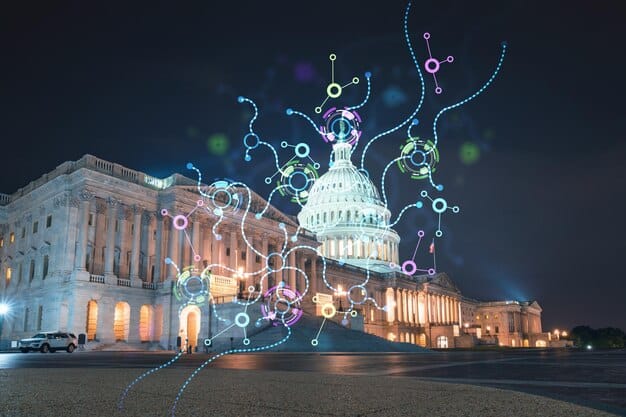Cybersecurity Threats to US Critical Infrastructure & New Defenses

The escalating sophistication of cyber threats jeopardizes the foundational systems supporting the United States, prompting the deployment of advanced, multi-layered defensive strategies aimed at enhancing resilience and safeguarding critical infrastructure.
The digital age, while offering unparalleled connectivity and efficiency, simultaneously introduces complex vulnerabilities, particularly concerning the foundational systems that underpin modern society. In this evolving landscape, understanding the nature of Cybersecurity Threats to US Critical Infrastructure: What New Defenses Are Being Deployed? becomes paramount, as these systems, from energy grids to financial networks, are increasingly targeted by state and non-state actors alike. The integrity and continuous operation of these vital assets are directly tied to national security, economic stability, and public safety, making their protection a matter of urgent national priority. This necessitates a proactive and adaptive approach, moving beyond traditional perimeter defenses to embrace comprehensive strategies that can detect, deter, and respond to ever-more sophisticated cyber adversaries.
The Evolving Landscape of Cyber Threats to US Infrastructure
The digital realm has become a primary conduit for geopolitical competition, with nations and rogue actors vying for strategic advantage through cyber means. This translates into concrete and escalating threats against the United States’ critical infrastructure, which forms the bedrock of its societal and economic functions. The tactics employed are no longer limited to basic denial-of-service attacks but encompass highly sophisticated, persistent intrusions aimed at disruption, espionage, or even physical destruction. This section delves into the intricate nature of these evolving cyber threats and the adversaries behind them.
Advanced Persistent Threats (APTs) represent a significant challenge, as they are characterized by their stealth, long-term presence within networks, and access to significant resources. These threat actors, often state-sponsored, meticulously plan and execute campaigns specifically designed to compromise critical systems without immediate detection. Their objectives can vary from intellectual property theft and espionage to pre-positioning for future destructive attacks. The sheer scale and determination of these groups demand an equally persistent and sophisticated defense.
The proliferation of ransomware and supply chain attacks further complicates the threat landscape. Ransomware, once a tool primarily for financial gain, has evolved into a national security concern, capable of paralyzing entire sectors, as seen with recent incidents impacting fuel pipelines and healthcare providers. Supply chain attacks, where adversaries compromise trusted software or hardware vendors to inject malicious code into their products, offer a particularly insidious vector for widespread infiltration, bypassing traditional security controls. These methods exploit the interconnectedness of modern systems, leveraging trust relationships to propagate malicious payloads silently.
Targeted Industries and Adversaries
Cyber adversaries do not operate indiscriminately; they often target specific sectors with high strategic value. The energy sector, including electricity grids and oil and gas pipelines, is a perennial target due to its foundational role in all other critical infrastructure elements. Disruption here can cascade, causing widespread blackouts or fuel shortages. The financial services sector is another prime target, not just for monetary theft but also for destabilizing economic systems through data manipulation or service disruption. Beyond these, the defense industrial base, water utilities, and healthcare systems all face constant, tailored threats.
* Energy Sector: Vulnerable to attacks aiming for disruption, espionage on operational technology (OT) systems, and supply chain infiltration.
* Financial Services: At risk from data breaches, ransomware, and efforts to undermine trust in financial markets.
* Water Utilities: Potential targets for disruption of essential services, with direct public health implications.
* Healthcare and Public Health: Frequently targeted by ransomware, leading to patient data compromise and service interruptions, particularly during crises.
The adversaries behind these threats are diverse, ranging from nation-states with sophisticated cyber capabilities to well-resourced cybercriminal organizations and ideological hacktivists. Nation-state actors often seek strategic advantages, influence, or the ability to disable an adversary’s capabilities in a conflict. Cybercriminals are primarily motivated by financial gain but can be leveraged by state actors or inadvertently cause widespread disruption. Their methods are constantly refined, forcing defenders into a perpetual race to keep pace. Understanding the motive and capabilities of these diverse actors is crucial for developing effective defensive strategies tailored to specific threat levels. Law enforcement and intelligence agencies continuously monitor these groups, sharing threat intelligence to fortify defenses across public and private sectors.
In conclusion, the threat landscape to US critical infrastructure is dynamic, multifaceted, and escalating. It demands a holistic understanding of the tactics, techniques, and procedures (TTPs) employed by a diverse array of adversaries. Without robust defensive measures, these threats pose significant risks to national security and societal well-being.
Bolstering Resilience: Key Defense Strategies and Frameworks
Recognizing the pervasive nature of cyber threats, the United States government and private sector partners have initiated and adopted a spectrum of defense strategies and frameworks designed to enhance the resilience of critical infrastructure. This collective effort moves beyond simple patch management and antivirus software, embracing a holistic, multi-layered approach to security. The focus is not just on preventing attacks but also on minimizing their impact and rapidly recovering from breaches. This section explores the foundational strategies and the frameworks guiding these efforts.
One cornerstone of modern cybersecurity defense is the implementation of robust risk management frameworks. These frameworks provide a structured approach to identifying, assessing, and mitigating cyber risks across complex systems. The National Institute of Standards and Technology (NIST) Cybersecurity Framework (CSF) stands out as a preeminent example. It provides a common language and systematic process for organizations to manage and reduce their cybersecurity risks. The CSF is voluntary but widely adopted due to its flexibility and effectiveness in various sectors, from finance to manufacturing.
NIST Cybersecurity Framework and Sector-Specific Initiatives
The NIST CSF guides organizations through five core functions: Identify, Protect, Detect, Respond, and Recover. This iterative approach helps organizations understand their current risk posture, implement appropriate safeguards, maintain continuous monitoring, develop incident response plans, and ensure business continuity. Its adaptability makes it invaluable for diverse critical infrastructure operators, allowing them to tailor its implementation to their specific operational technology (OT) and information technology (IT) environments.
* Identify: Understanding critical assets, systems, and data to determine risk.
* Protect: Implementing safeguards to ensure delivery of critical services.
* Detect: Developing capabilities to identify cybersecurity events.
* Respond: Planning for and containing the impact of cyber incidents.
* Recover: Restoring capabilities and services impaired by cyber incidents.
Beyond general frameworks, sector-specific initiatives play a crucial role. For instance, the Department of Energy (DOE) works closely with the electricity sector to develop tailored cybersecurity guidelines and share threat intelligence, recognizing the unique operational technology considerations of energy grids. Similarly, the Department of Homeland Security (DHS), through its Cybersecurity and Infrastructure Security Agency (CISA), collaborates with critical infrastructure owners and operators across all 16 sectors, providing technical assistance, vulnerability assessments, and incident response support. These sector-specific efforts ensure that defenses are not only comprehensive but also deeply relevant to the operational realities and regulatory environments of each industry.
Furthermore, a significant shift in defense strategy involves improving operational technology (OT) security. Many critical infrastructure systems rely on industrial control systems (ICS) and supervisory control and data acquisition (SCADA) systems designed decades ago with little consideration for cyber threats. Modernizing and securing these OT environments, which often run legacy software and hardware, presents unique challenges. New defenses include implementing network segmentation, stricter access controls, continuous monitoring for anomalies, and developing specialized incident response plans for OT environments, recognizing that these systems can have physical consequences if compromised. This involves isolating critical operational networks from IT networks, establishing secure remote access, and deploying purpose-built security solutions that understand industrial protocols.
In summary, the strategies to bolster critical infrastructure resilience are multifaceted, encompassing broad risk management frameworks like NIST CSF and specific sector-driven initiatives. The ongoing focus on securing operational technology and establishing robust incident response capabilities signifies a mature and adaptive approach to defending against evolving cyber threats.
Advanced Technologies and Tools in Defense
The rapid evolution of cyber threats demands an equally rapid advancement in defensive technologies. Relying solely on traditional firewalls and antivirus solutions is no longer sufficient against sophisticated, adaptive adversaries. The deployment of cutting-edge technologies and innovative tools is central to the United States’ strategy for protecting critical infrastructure. These advanced solutions are designed to provide deeper visibility, more rapid detection, and automated response capabilities, moving the defensive posture from reactive to proactive.
One of the most impactful advancements in cybersecurity defense is the increasing adoption of Artificial Intelligence (AI) and Machine Learning (ML). These technologies analyze vast quantities of data from network traffic, system logs, and security feeds to identify anomalous patterns that may indicate a cyberattack. Unlike signature-based detection, AI/ML can recognize novel threats and sophisticated attack techniques that elude traditional rule sets. Whether it’s detecting insider threats, identifying zero-day exploits, or categorizing malware variants, AI and ML algorithms significantly enhance an organization’s ability to spot and respond to threats in real-time. This includes predictive analytics, where AI models forecast potential attack vectors based on historical data and current threat intelligence.
Another critical area of technological deployment is advanced threat intelligence platforms. These platforms aggregate, normalize, and analyze threat data from multiple sources, including government agencies, private security firms, and open-source intelligence. By providing timely and actionable insights into adversary TTPs, vulnerabilities, and emerging threats, these platforms enable organizations to proactively adjust their defenses, strengthen weak points, and prepare for anticipated attacks. Information sharing, often facilitated by these platforms, is crucial for developing a collective defense posture among critical infrastructure stakeholders.

Zero Trust Architecture and Quantum-Resilient Cryptography
The “Zero Trust” security model is gaining significant traction across critical infrastructure sectors. This model operates on the principle of “never trust, always verify,” meaning that no user, device, or application is inherently trusted, regardless of their location within or outside the network perimeter. All access requests are authenticated and authorized based on a dynamic assessment of risk and context. This significantly reduces the attack surface and mitigates the impact of insider threats or compromised credentials, as malicious actors cannot easily move laterally once inside a network. Implementing Zero Trust involves granular access controls, continuous monitoring, and micro-segmentation of networks.
* Explicit Verification: Authenticate and authorize every access request rigorously.
* Least Privilege Access: Grant users only the minimum access rights required for their tasks.
* Assume Breach: Design security with the assumption that a breach is inevitable, focusing on containment and rapid response.
* End-to-End Encryption: Encrypt all communications, both in transit and at rest.
Looking to the future, the development and eventual deployment of quantum-resilient cryptography represent a strategic imperative. While quantum computers capable of breaking current encryption standards are still nascent, the threat they pose to the confidentiality of long-term data (e.g., national secrets, critical infrastructure designs) is substantial. Research and development are underway to create new cryptographic algorithms resistant to quantum attacks. Proactive migration to these “post-quantum” cryptographic standards will be essential to secure critical communications and data against future threats. This long-term defense strategy underscores the forward-thinking approach being taken to protect foundational systems.
In essence, the technological advancements in defense are multifaceted, ranging from the intelligent automation offered by AI/ML to the paradigm shift of Zero Trust and the forward-looking preparations for quantum computing. These deployments are critical in building robust, adaptive defenses capable of safeguarding the nation’s most vital assets.
Public-Private Partnerships and Information Sharing
In the complex and interconnected landscape of cybersecurity, no single entity can effectively combat threats alone. The vast majority of critical infrastructure in the United States is owned and operated by the private sector, while the federal government possesses unique intelligence, law enforcement capabilities, and regulatory authority. This inherent duality necessitates strong, collaborative partnerships between the public and private sectors, coupled with robust mechanisms for information sharing. These collaborations are crucial for building a cohesive national cyber defense posture.
Formal and informal public-private partnerships facilitate a two-way exchange of vital information. Government agencies, such as CISA, the FBI, and the National Security Agency (NSA), share timely threat intelligence, vulnerability alerts, and incident analysis with critical infrastructure owners and operators. This allows private companies to proactively implement defensive measures, patch systems, and prepare for specific attack vectors identified by federal intelligence. Conversely, private sector entities, often the first targets of cyberattacks, provide valuable insights into emerging threat TTPs, attack indicators, and the effectiveness of defensive strategies. This real-world operational data is essential for government agencies to refine their own understanding of the threat landscape and develop more effective countermeasures.
Information Sharing and Analysis Centers (ISACs) serve as a prominent example of successful public-private collaboration. Established across various critical infrastructure sectors (e.g., Electricity ISAC, Financial Services ISAC, Water ISAC), these non-profit organizations act as central hubs for gathering, analyzing, and disseminating cybersecurity threat information among their members and with government partners. ISACs provide a trusted platform for competitors within a sector to share sensitive threat data anonymously, fostering a collective defense ecosystem. Their role extends beyond simple information exchange; they often facilitate best practice sharing, provide training, and coordinate incident response efforts within their respective sectors.
Regulatory Initiatives and Collaborative Frameworks
The federal government has also implemented a series of regulatory and policy initiatives aimed at strengthening cybersecurity requirements for critical infrastructure, particularly in sectors deemed high-risk. While the degree of regulation varies, these initiatives often mandate adherence to specific security frameworks, require incident reporting, and encourage proactive risk assessments. The NERC Critical Infrastructure Protection (CIP) standards, for example, impose mandatory cybersecurity requirements on electric utilities, covering areas from electronic security perimeters to personnel training and supply chain risk management. These regulations aim to raise the baseline security posture across entire sectors.
* Executive Orders: Presidential directives to enhance federal cybersecurity and promote information sharing with the private sector.
* Cybersecurity Directives: Specific mandates from federal agencies to critical infrastructure entities within their purview.
* Voluntary Partnerships: Programs like the Cybersecurity Shared Services and Supply Chain initiatives where government and industry co-develop best practices.
Beyond regulations, collaborative frameworks such as Joint Cyber Defense Collaborative (JCDC) established by CISA are designed to unite government, industry, and international partners to achieve shared cybersecurity goals. JCDC brings together operational planning and real-time defense against malicious cyber activity, particularly in areas like ransomware and critical infrastructure protection. This proactive, coordinated approach allows for joint planning and synchronized responses to significant cyber events, moving beyond simple information sharing to active operational collaboration. These initiatives highlight a recognition that an integrated defense, leveraging the unique strengths of both public and private entities, is the most effective way to safeguard national critical infrastructure against increasingly sophisticated cyber threats.
In conclusion, robust public-private partnerships and efficient information sharing mechanisms are foundational to the cybersecurity of US critical infrastructure. By fostering trust and leveraging collective intelligence, these collaborations significantly enhance the nation’s ability to anticipate, detect, and respond to cyber threats.
Challenges and Future Outlook in Cybersecurity Defense
Despite significant advancements in defense strategies and the deployment of advanced technologies, the protection of US critical infrastructure against cyber threats remains a highly dynamic and challenging endeavor. The adversarial landscape is constantly evolving, presenting new complexities that require continuous adaptation and innovation. Understanding these ongoing challenges and anticipating future trajectories is crucial for developing resilient and effective long-term cybersecurity strategies.
One primary challenge stems from the sheer complexity and legacy nature of many critical infrastructure systems. Many operational technology (OT) environments, such as those found in energy grids or manufacturing plants, were not designed with cybersecurity in mind. They often rely on outdated hardware and software, lack robust security features, and are difficult to patch or upgrade without risking operational disruption. Integrating modern cybersecurity solutions into these legacy systems without compromising reliability or safety is a significant hurdle. Furthermore, the convergence of IT (information technology) and OT networks, while offering efficiency gains, also introduces new attack vectors and expands the overall attack surface, making network segmentation and continuous monitoring even more critical.
The persistent shortage of skilled cybersecurity professionals is another major impediment. There is a global talent gap, and the demand for experts proficient in defending complex industrial control systems, analyzing sophisticated malware, and developing robust incident response plans far outstrips the supply. This talent shortfall affects both government agencies and private critical infrastructure operators, leading to understaffed security teams and increased vulnerability. Addressing this shortage requires long-term investments in cybersecurity education, training programs, and initiatives to attract and retain top talent in national security roles.
Emerging Threats and Adaptations
Looking ahead, several emerging threats are likely to shape the future of critical infrastructure cybersecurity. The increasing proliferation of the Internet of Things (IoT) devices, both in industrial settings and consumer environments, creates a massive expansion of potential entry points for adversaries. Many IoT devices are deployed with weak security by default and are difficult to manage or update, making them prime targets for botnets and distributed denial-of-service (DDoS) attacks. Furthermore, the dark side of AI and machine learning could lead to more sophisticated automated attacks, rapidly evolving malware, and hyper-personalized phishing campaigns, requiring defenders to continuously enhance their own AI-driven capabilities.
* Supply Chain Risks: Growing complexity of global supply chains for hardware and software introduces multiple points of vulnerability.
* Insider Threats: Disgruntled employees or compromised privileged accounts pose a significant risk, requiring enhanced vigilance and access controls.
* Information Warfare: Cyber operations increasingly intertwine with disinformation campaigns aimed at eroding public trust in critical services.
* Quantum Computing: The distant but growing threat that quantum computers could break current encryption standards, necessitating development of quantum-resilient algorithms.
To meet these future challenges, critical infrastructure defense will require continuous adaptation, characterized by several key trends. Proactive threat hunting, moving beyond reactive detection to actively seek out adversaries within networks, will become more prevalent. The emphasis on resilience will deepen, focusing on not just preventing attacks but rapidly restoring services and maintaining continuity during and after a significant cyber event. International collaboration will also be more crucial than ever, as cyber threats transcend national borders, demanding coordinated responses and intelligence sharing among allied nations. Ultimately, the future of cybersecurity defense for critical infrastructure will be a persistent, adaptive race between offensive capabilities and defensive innovation, requiring sustained investment, strategic foresight, and unwavering commitment.
Legislative and Executive Actions to Fortify Defenses
The escalating nature of cybersecurity threats to US critical infrastructure has spurred significant legislative and executive action, underscoring a top-level commitment to fortifying national defenses. These governmental initiatives aim to provide a legal and policy framework for cybersecurity, establish clear responsibilities, mandate certain security practices, and foster greater collaboration among stakeholders. Such actions are crucial for creating a unified and effective national response to cyber risks.
One of the most consequential legislative efforts has been the passing of various acts that enhance the authority and resources of federal agencies involved in cybersecurity. For example, the Cybersecurity Act of 2015 encouraged voluntary cybersecurity information sharing between the government and the private sector, offering liability protections to companies that share threat data. More recently, the Cyber Incident Reporting for Critical Infrastructure Act of 2022 mandated critical infrastructure entities to report significant cyber incidents and ransomware payments to CISA, providing the agency with timelier and more comprehensive visibility into the threat landscape. This real-time intelligence is vital for understanding attack patterns, issuing alerts, and coordinating rapid responses.
Executive orders have also played a pivotal role in shaping federal cybersecurity policy and setting expectations for critical infrastructure protection. Executive Order 14028, “Improving the Nation’s Cybersecurity,” issued in May 2021, represents a comprehensive roadmap for enhancing US cybersecurity. It directly addresses deficiencies in federal cybersecurity practices, mandates a move towards Zero Trust architecture, promotes the use of common security standards, and emphasizes the importance of secure software supply chains. While primarily focused on federal agencies, the order’s principles and requirements often serve as best practices and influence security standards across the broader critical infrastructure community.

Government Agencies and Strategic Directives
Several government agencies are at the forefront of implementing these legislative and executive mandates. CISA, within the Department of Homeland Security, is designated as the national coordinator for critical infrastructure security and resilience. Its role encompasses providing cyber threat warnings, vulnerability assessments, and incident response assistance to public and private entities. CISA’s “Shields Up” campaign, for instance, provides guidance and resources to organizations to bolster their defenses in response to geopolitical tensions.
* NIST: Develops cybersecurity standards and guidelines, including the widely adopted Cybersecurity Framework.
* NSA: Provides classified threat intelligence and actively works to counter foreign adversaries in cyberspace.
* FBI: Investigates cybercrimes and works to disrupt malicious cyber campaigns originating from criminal and state-sponsored actors.
* Department of Energy: Focuses on securing the energy sector, including electricity grids and oil and gas infrastructure, through R&D and collaboration.
Furthermore, strategic directives are issued to guide specific sectors or address particular vulnerabilities. The National Security Memoranda (NSM) series, replacing the Presidential Policy Directives (PPDs) and National Security Presidential Memoranda (NSPMs) of previous administrations, are used to set high-level policy. For example, NSM-8 addresses improving cybersecurity for critical infrastructure control systems, emphasizing collaboration and information sharing. These directives often translate into new compliance requirements, funding allocations for cybersecurity initiatives, and mandates for federal agencies to assist critical infrastructure operators. The cumulative effect of these legislative and executive actions is a continuous strengthening of the legal and operational framework for cybersecurity, adapting to the dynamic threat environment and ensuring the nation’s vital services remain resilient against malicious cyber activity. This comprehensive approach reflects a recognition that protecting critical infrastructure is a shared responsibility requiring concerted efforts across all levels of government and industry.
International Cooperation and Global Cyber Norms
Cybersecurity threats are inherently borderless. A malicious actor operating from one continent can effortlessly launch an attack on critical infrastructure located thousands of miles away, highlighting the indispensable need for international cooperation. The United States recognizes that a truly resilient cyberspace cannot be achieved in isolation and has actively pursued diplomatic engagements, intelligence sharing agreements, and the development of global norms of behavior in cyberspace. These international efforts are crucial for building a collective defense mechanism against state-sponsored attacks, cybercrime, and other transnational cyber threats.
Bilateral and multilateral agreements form the bedrock of international cybersecurity cooperation. The United States engages with key allies, such as members of NATO and the “Five Eyes” intelligence alliance (Australia, Canada, New Zealand, and the United Kingdom), to share threat intelligence, coordinate incident response, and conduct joint cyber exercises. These partnerships allow for a deeper understanding of adversary TTPs, facilitate rapid response to transnational cyberattacks, and ensure that collective capabilities are leveraged effectively. Beyond traditional alliances, the US also seeks to build capacity in developing nations, recognizing that weak cybersecurity in any country can create vulnerabilities that eventually impact global systems.
The development and promotion of international norms of responsible state behavior in cyberspace are a long-term diplomatic priority. These norms aim to establish clear expectations for how states should conduct themselves in the digital realm, especially concerning critical infrastructure. Initiatives within the United Nations (UN) and the Group of Governmental Experts (GGE) have produced widely endorsed reports outlining principles such as the applicability of international law to cyberspace, the importance of protecting critical infrastructure from attack, and the necessity of responding to requests for assistance in investigating cybercrimes. While these norms are not legally binding treaties, they provide a moral and political framework for accountability and deterrence, discouraging malicious state-sponsored cyber activities.
Combatting Cybercrime and Capacity Building
International cooperation is also vital in the fight against transnational cybercrime. Organizations like INTERPOL and Europol collaborate with the FBI and other US law enforcement agencies to apprehend cybercriminals, dismantle criminal networks, and seize illicit assets. This involves intelligence sharing, coordinated law enforcement operations, and mutual legal assistance treaties to overcome jurisdictional challenges. The transnational nature of cybercrime means that effective prosecution and deterrence require close collaboration among national law enforcement bodies.
* Budapest Convention on Cybercrime: A key international treaty that provides a common framework for countries to criminalize cyber offenses and facilitate international cooperation in investigations.
* G7 and G20 Declarations: Statements from major economies emphasizing the importance of cybersecurity and commitments to international cooperation.
* Cybersecurity Capacity Building: Programs where the US government and NGOs help other nations develop their own cybersecurity capabilities, including training, policy development, and technical assistance.
Furthermore, capacity building initiatives play a crucial role in strengthening global cyber resilience. The United States actively supports programs designed to help other nations develop their own cybersecurity expertise, legal frameworks, and technical infrastructure. This includes providing training to foreign government officials, assisting with the establishment of national Computer Emergency Response Teams (CERTs), and sharing best practices for critical infrastructure protection. By raising the overall global standard of cybersecurity, these initiatives contribute to a more secure and stable international digital environment, ultimately benefiting US critical infrastructure by reducing the number of vulnerable points in the interconnected global network. In essence, international cooperation and the promotion of global cyber norms are not merely diplomatic niceties but rather strategic imperatives for comprehensive critical infrastructure defense in an increasingly hyper-connected world. They represent a collective investment in shared security and stability.
| Key Point | Brief Description |
|---|---|
| 🛡️ Evolving Threats | Threats like APTs, ransomware, and supply chain attacks are increasingly sophisticated and targeted at critical sectors. |
| ⚙️ Defense Strategies | NIST CSF, sector-specific initiatives, and improved OT security enhance resilience and risk management. |
| 🧪 Advanced Tech | AI/ML, Zero Trust, and quantum-resilient cryptography are vital for proactive defense and detection. |
| 🤝 Public-Private Sync | Collaboration with ISACs, regulatory mandates, and shared intelligence bolster collective defense. |
Frequently Asked Questions About US Critical Infrastructure Cybersecurity
US critical infrastructure comprises systems and assets so vital that their incapacitation or destruction would have a debilitating effect on security, national economic security, national public health or safety, or any combination thereof. This encompasses 16 diverse sectors, including energy, transportation systems, financial services, communications, healthcare, and water systems.
The primary adversaries are sophisticated nation-state actors seeking strategic advantage, wealth-motivated cybercriminal organizations, and politically or ideologically driven hacktivists. These groups vary in their capabilities, resources, and objectives, necessitating a multi-layered and adaptive defense strategy across all critical sectors.
AI and ML significantly enhance cyber defenses by rapidly analyzing vast datasets to detect anomalous patterns indicative of attacks, including novel threats (zero-days) that traditional signature-based systems miss. They enable predictive analytics, automate threat detection, and improve anomaly identification, leading to faster and more effective responses.
The NIST Cybersecurity Framework provides a voluntary, risk-based approach for organizations to manage and reduce their cybersecurity risks. It outlines five core functions: Identify, Protect, Detect, Respond, and Recover, offering a flexible guide for organizations across various critical infrastructure sectors to improve their security posture and resilience.
Public-private partnerships are crucial because most critical infrastructure is privately owned while the government possesses unique intelligence. These collaborations facilitate vital two-way information sharing, coordinating efforts, and leveraging collective expertise and resources to effectively anticipate, detect, and respond to complex, transnational cyber threats.
Conclusion
The relentless pace of digital transformation, while delivering immense societal benefits, has irrevocably intertwined the physical and cyber worlds, elevating the threat to critical infrastructure to a paramount national security concern. The journey to secure these vital systems, from energy grids to financial networks, is an ongoing and adaptive race against increasingly sophisticated adversaries. Through a combination of robust defense strategies, the deployment of advanced technologies like AI and Zero Trust, unwavering public-private partnerships, and proactive international cooperation, the United States is deploying multi-faceted and dynamic defenses. While challenges persist in the form of legacy systems and a talent gap, the continuous evolution of protective measures and a shared commitment across government and industry offer a pathway toward greater resilience. Safeguarding critical infrastructure is not merely a technical endeavor; it is a collective responsibility, fundamental to national security, economic stability, and the daily lives of citizens. The future of this defense will depend on continued innovation, vigilance, and strategic collaboration to ensure the nation’s foundational systems remain secure and operational.





